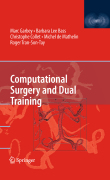
Computational surgery and dual training
Garbey, Marc
Bass, Barbara Lee
Collet, Christophe
Mathelin, Michel de
The new and emerging field of computational surgery will improve the efficiency and quality of surgery and will give patients access to very complex surgical operations that require extreme precision and minimum intrusion. In order to effectively deploy computational surgery techniques in life threatening cases such as inoperable cancer tumors that have invaded critical artery tissues or the nervous system, surgeons will have to become very familiar with computing methods, such as image analysis, augmented reality and robotics. Computational Surgery and Dual Training provides the necessary background in computer andsurgical techniques that will enable computer scientists/biomedical engineersand surgeons to work together to improve interventional procedures and surgeries. First book on computational surgery and dual training Provides a foundation in surgical methods for biomedical engineers who wish to do research in thesurgical area Includes material on surgery applications and biomedical modeling Detailed discussion of imaging and optimization in computational surgery INDICE: Part I: Surgery Applications and Biomedical Modeling. Abdominal surgery with parascopy procedures. Pancreas surgery procedure. Vein graft surgery. Inflammation and cell dynamic. Biology of pancreas cancer.- Part II: Methods of Computational Surgery. Hemodynamic and vascular surgery. Augmented reality and brain surgery. Quantitative imaging. System biology. Augmented reality in abdominal surgery. Medical robotics. Optimization in image and signal processing. Lung dynamics. Cancer modeling.- Part III: Training in Computational Surgery. Training of surgeons with parascopy. Training of surgeons with computational tools. Medical imaging. Surgery procedures.
- ISBN: 978-1-4419-1122-3
- Editorial: Springer
- Encuadernacion: Cartoné
- Páginas: 400
- Fecha Publicación: 01/10/2009
- Nº Volúmenes: 1
- Idioma: Inglés
